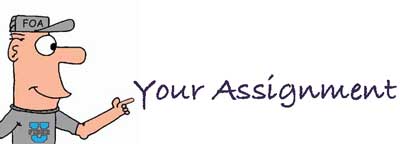Objectives:
From this lesson you should learn:
What is an FOA certified instructor expected to know about
premises cabling?
Where can additional technical information be found for
use in classes?
What kinds of technical questions will FOA ask instructors
on the exam?
What Is A FOA
Certified Instructor Expected To Know?
A FOA CPCT/I certified
instructor is expected to have a good basic knowledge of
premises cabling, including UTP and coax, fiber optics and
wireless. In addition, the instructor is expected to know
what resources are available for their students and
themselves to study some topics in greater depth. And, of
course, the instructor is expected to keep up to date on
the technology.
You must realize FOA is a broad-based professional society
that covers all applications of fiber optics and premises
cabling - not just LAN and telecom, but fiber to the home (FTTH), CATV, data,
security, energy, military, wireless, sensors,
manufacturing, R&D, etc., etc., etc. The FOA advisors
themselves come from many different application
backgrounds and all FOA programs are based on the KSAs
(knowledge, skills and abilities) expected of a tech in any
industry using fiber optics. We expect our schools and
instructors to cover the basics from the KSAs but add
relevant materials for the application focus of their
course.
Among
the FOA advisors who have helped develop the FOA's vast
resources of technical materials and who provide the
guidance for creating our KSAs
and exams, there are some classic jokes. One involves what
we call "copperheads" - those who think all cabling is
copper - and "standards wonks" - those who learn all the
standards but have little practical applications
knowledge. Another big issue is keeping up with
technology. You're expected to know how all media are used
to support the latest LANs and other applications. And you
are expected to know that "Cat 7" never existed in the US
and "Cat 8" is years away from standardization - if ever.
Why
are all those twists inside a Cat 5 jack?

But we all, with
good humor, say "we do it the FOA way." And
surely, there is a "FOA way." This self-study program is
designed to introduce you to the FOA way and help you
review the tech topics we consider essential to teaching a
course on premises cabling.
We
all have to deal with industry standards, since without
them, no network could possibly work. We expect our
schools to teach their students about standards, where
they are relevant and how to use them in their work. We
also are realistic about standards, either US or
international. Standards are often confusing, constantly
changing and expensive. They are also usually way behind
new technology and often are already abandoning past
applications. Not everyone is either installing new
systems for the latest high speed networks or abandoning
currently useful networks.
You
need to be aware of the standards information on the FOA
website and how to find more information on US,
international and FOA standards and how to lead your
students to this reference material when they need it.
FOA does not require instructors use the FOA curriculum
materials and many use their own curriculum they have
developed over years of teaching. We make the FOA
curriculum available free to those who do not want or have
time to develop their own. We encourage instructors to
customize the materials to fit their own course aims or
even translate to the language of their students. But
whether you use your curriculum or ours, you should ensure
that you cover the FOA KSAs
in order the meet the requirements for FOA certification.
The other
unique aspect of the "FOA way" is our making technical
information available free to all. Our hundreds of pages
of technical information in the FOA
Guide and online self-study programs on Fiber
U are provided free to the industry so there is a
unbiased source of technical information available to keep
the industry growing.
The Technical
Knowledge
FOA created the
CPCT certification around a base of knowledge that all the
FOA founding advisors agreed that every tech should know,
no matter what their job. This material is in our book, The
FOA Reference Guide To Premises Cabling, the section
of the FOA Online Guide called "Premises
Cabling Systems," on the FOA
YouTube Lecture Series on Premises Cabling and
is covered in the Fiber U self-study program "Premises
Cabling."
As a prospective instructor, we expect you to have good
basic knowledge of premises cabling and we also expect you
to have a reasonable assessment of your own knowledge.
Thus we provide links below for you to study what you feel
you need to study to ensure your knowledge is adequate.
When you feel you think you are prepared, take the quiz.

Assignment:
Take the Fiber
U online self-study course on Premises
Cabling. Use the quizzes on each section to
evaluate your knowledge.
Test your comprehension:
After studying the Fiber U Basic Fiber Optics course, take this test to
check your comprehension - it uses the ClassMarker online testing
service that you will use to take the Instructor Certification Exam:
Link: https://www.classmarker.com/online-test/start/?quiz=kbe659e1ba1da592
Password: Use the password given to you when you were directed to take this course or contact FOA at info(at)foa.org
When you have completed Lesson 1a and Lesson 2 and are ready to take the FOA CPCT/I Instructor Certification Exam, contact FOA for directions.
Lessons
Lesson
1: Technical Topics - Fiber Optics (CFOT, CFOS/I)
Lesson 1a: Technical Topics - Premises Cabling (CPCT,
CPCT/I only)
Lesson 2:
Teaching The FOA Way
Instructor Exam:
Taking the CFOS/I or CPCT/I Exam
Back to the Lesson Plan
|

